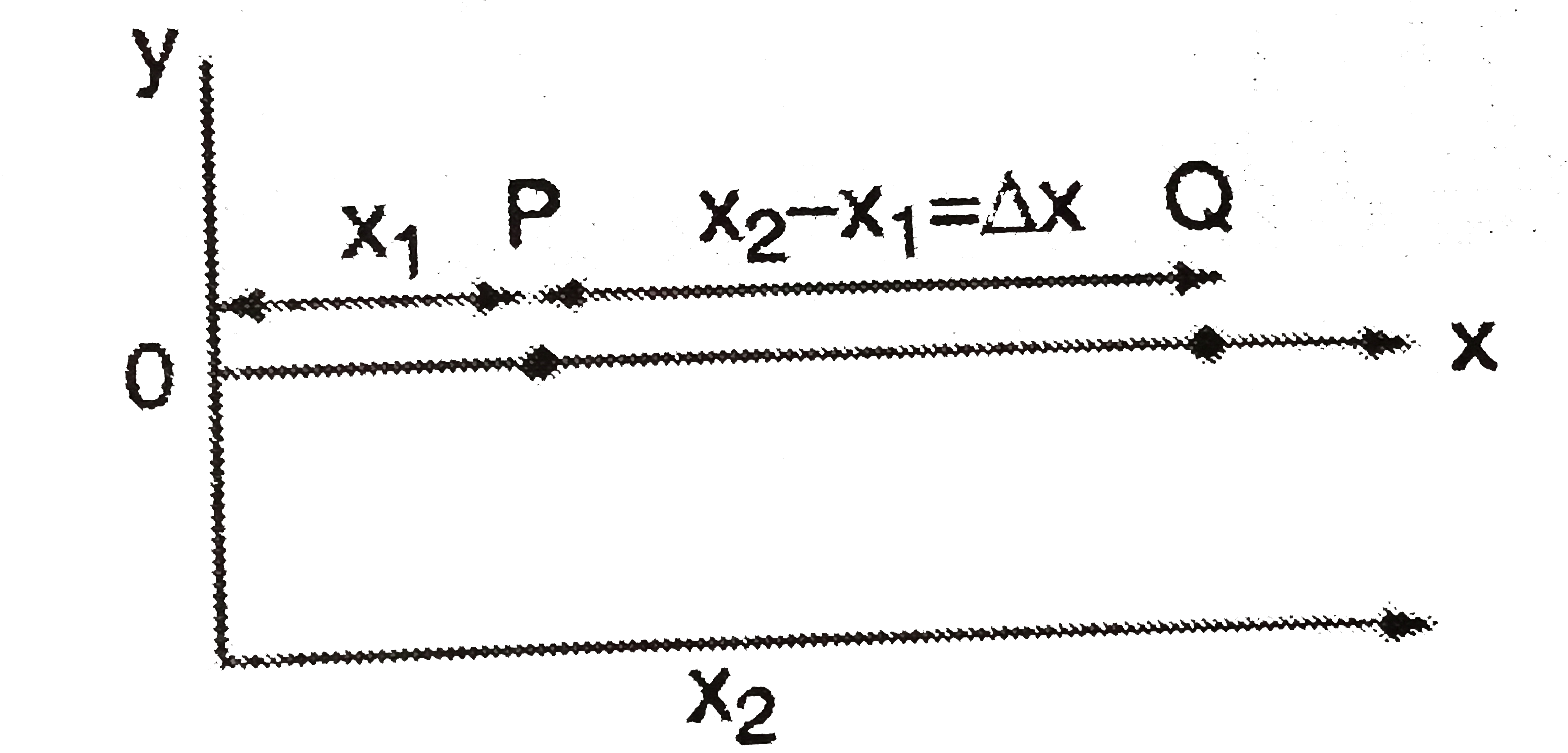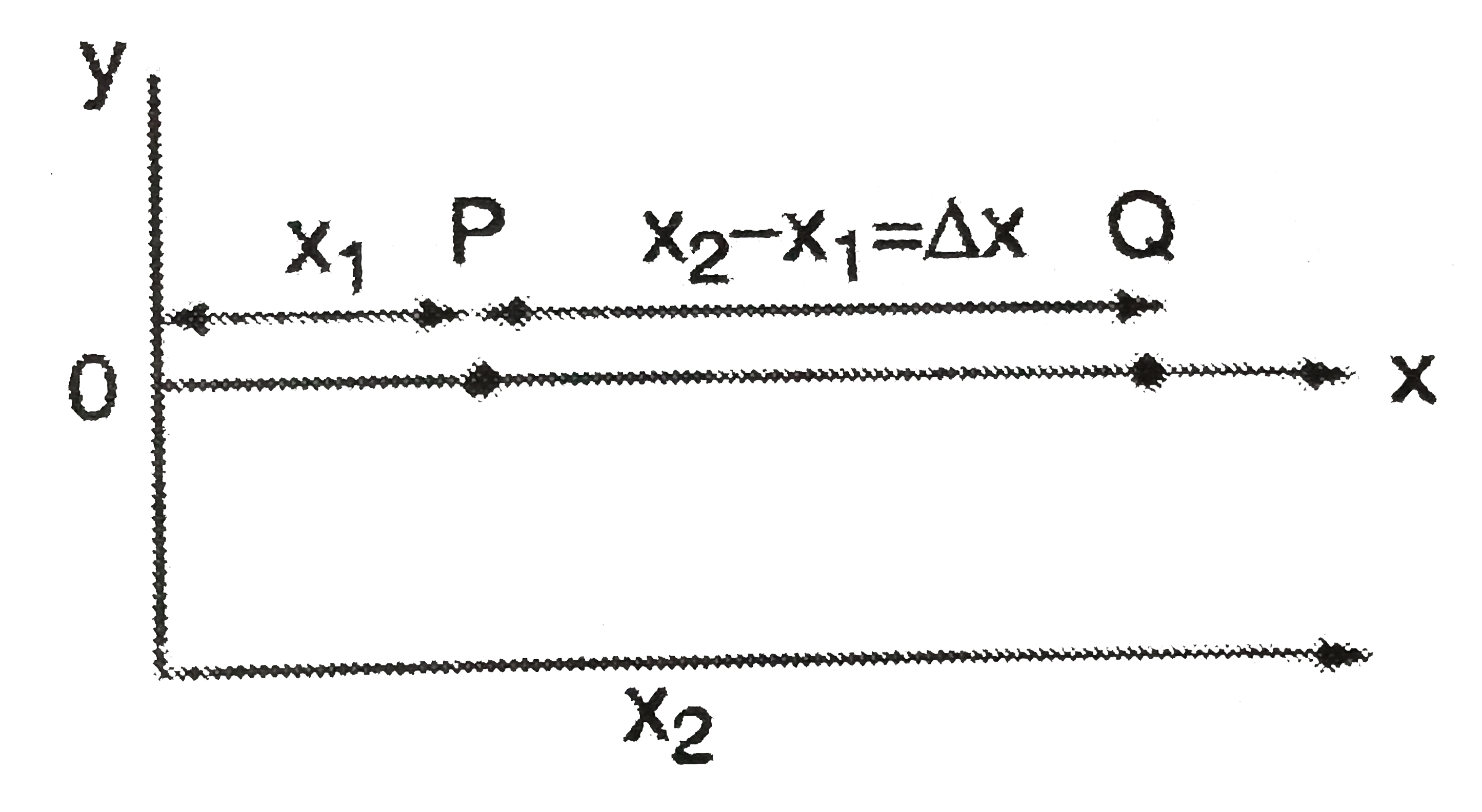Consider a particle moving along x-axis. Its distance from origin O is described by the co-ordinate x which varies with time. At a time t1, the particle is at point P, where its co-ordinate is x1 and at time t2, the particle is at point Q, where its co-ordinate is x2. The displacement during the time interval from t1 to t2 is the vector from P to Q, the x-component of this vector is (x2−x1) and all other components are zero.
It is convenient to represent the quantity x2−x1 the change in x by means of a notation Δ, thus Δx=x2−x1 and Δt=t2−t1.

The average velocity ¯¯¯V=x2−x1t2−t1=ΔxΔt
The resistive force suffered by a motor boat is proportional to v2, where v is instantaneous velocity. The engine was shut down when the velocity of the boat was v0. Find the average velocity at any time t.
v0+v2
vv02(v0+v)
vv0loge(v0v)(v0−v)
2vv0loge(v0v)(v0+v)
The correct Answer is:C
F∝v2
F=−Kv2
mdvdt or mvdvds=−kv2
⇒vdvdt=−cv2
⇒∫vv0dvv=−C∫s0ds
Topper's Solved these Questions
- MOTION IN A STRAIGHT LINEBOOK - GRB PUBLICATIONCHAPTER - MOTION IN A STRAIGHT LINEEXERCISE - Integer
5 Videos
- FRICTION AND CIRCULAR MOTION BOOK - GRB PUBLICATIONCHAPTER - FRICTION AND CIRCULAR MOTION EXERCISE - Comprehension type
11 Videos
- MOTION IN TWO AND THREE DIMENSIONSBOOK - GRB PUBLICATIONCHAPTER - MOTION IN TWO AND THREE DIMENSIONSEXERCISE - All Questions
210 Videos
Similar Questions
Knowledge Check
Consider a particle moving along x-axis. Its distance from origin O is described by the co-ordinate x which varies with time. At a time t1, the particle is at point P, where its co-ordinate is x1 and at time t2, the particle is at point Q, where its co-ordinate is x2. The displacement during the time interval from t1 to t2 is the vector from P to Q, the x-component of this vector is (x2−x1) and all other components are zero.
It is convenient to represent the quantity x2−x1 the change in x by means of a notation Δ, thus Δx=x2−x1 and Δt=t2−t1.

The average velocity ¯¯¯V=x2−x1t2−t1=ΔxΔt
A particle moves according to the equation x=t2+3t+4. The average velocity in the first 5 s is:A8 m/sB7.6 m/sC6.4 m/sD5.8 m/sConsider a particle moving along x-axis. Its distance from origin O is described by the co-ordinate x which varies with time. At a time t1, the particle is at point P, where its co-ordinate is x1 and at time t2, the particle is at point Q, where its co-ordinate is x2. The displacement during the time interval from t1 to t2 is the vector from P to Q, the x-component of this vector is (x2−x1) and all other components are zero.
It is convenient to represent the quantity x2−x1 the change in x by means of a notation Δ, thus Δx=x2−x1 and Δt=t2−t1.

The average velocity ¯¯¯V=x2−x1t2−t1=ΔxΔt
A particle moves half the time of its journey with u. The rest of the half time it moves with two velocities v1 and v2 such that half the distance it covers with v1 and the other half with v2. The net average velocity is: (Assume straight line motion)Au(v1+v2)+2v1v22(v1+v2)B2u(v1+v2)2u+v1+v2Cu(v1+v2)2v1D2v1v2u+v1+v2A particle is moving along x-axis. Its velocity v with x co-ordinate is varying as v=√x. Then
Ainitial velocity of particle is zeroBmotion is non-uniformly acceleratedCacceleration of particle at x=2m is 12m/s2Dacceleration of particle at x=4m is 1m/s2
A particle moves along X-axis in such a way that its coordinate X varies with time t according to the equation x=(2−5t+6t2)m. The initial velocity of the particle is
View SolutionA particle moves along x - axis in such a way that its x - co - ordinate varies with time according to the equation x=4−2t+t2. The speed of the particle will vary with time as
View SolutionA particle moves along x-axis such that its distance from the origin at the end of time t minutes is given by x=√t2+1−2t. Its acceleration at t=√3 is
View SolutionA particle moves along X-axis in such a way that its coordinate X varies with time t according to the equation x=(2−5t+6t2)m. The initial velocity of the particle is
View SolutionA particle moves along x axis in such a way that its coordinate x varies with time t according to the equation x=A0−A1t+A2t2. The initial velocity of the particle is.
View Solution
